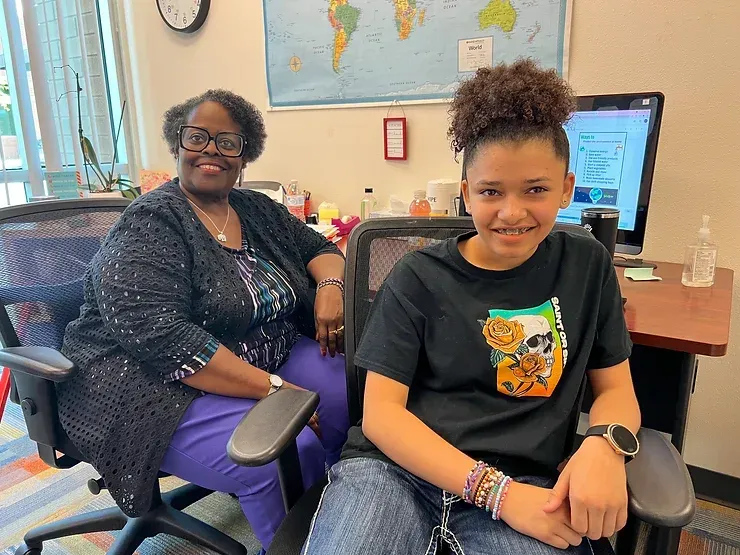The Hurricane Machine for an ADHD Brain
I work with a lot of students who have ADHD and struggle with focus and writing. Although many see this as a detriment and try to slow them down, trying to force an ADHD brain to operate like a neurotypical brain can be frustrating and demotivating for the student. However, I find their ability to hyper-process a strength and appreciate their ability to take in so much stimulation, even if it causes them fatigue. Helping them to embrace how their brain functions and use that to their advantage will help them adapt and find ways to harness the power that they have. Below are some tips on how to support students with ADHD in their learning.
Imagine that an ADHD brain is like a hurricane machine, constantly swirling thoughts, ideas, distractions, and emotions. The winds are powerful, and the storm is unpredictable. One moment, you’re focused on a task, and the next, you’re swept away by a new thought or feeling, leaving you feeling lost in the storm. However, if you could adapt the hurricane machine, you could use it to help manage the whirlwind of energy. Here’s how:
1. Focus Zones (Creating and accessing the “Calm Eye”)
An ADHD brain is constantly swirling with and processing ideas, sounds, feelings, and energy, and at the center of the storm, there’s a “calm eye”—a place where focus can be found. To create this calm space, students can use techniques like mindfulness, deep breathing, or a dedicated quiet space. Rather than forcing the storm to stop, these techniques help students center themselves within it, finding focus even amid the chaos. This is about creating pockets of calm where they can refocus, even as the storm continues to rage around them.

2. Structured Routines (Harnessing the Winds of the Hurricane)
The wind in the hurricane is powerful, and rather than fighting it, we can harness its energy (imagine if we could this as a viable energy source…). ADHD students often have bursts of creativity and energy that can be used to propel them forward. By using structured routines, such as the Pomodoro Technique (25 minutes of focused work followed by a 5-minute break), the swirling winds can be channeled into short bursts of productivity. This structure allows students to work with their natural energy levels while preventing overwhelm and burnout.
3. External Reminders and Supports (Guiding the Gales)
In the chaos of the storm, it’s easy to get lost or distracted. To guide ADHD students back on course, external supports—like to-do lists, alarms, or visual reminders—act as guiding winds. These tools help redirect attention back to the task at hand when they’ve been swept away by distractions. They can also help students track progress, so they feel a sense of accomplishment and direction, even when the storm threatens to pull them off course.
4. Rest and Recovery (Clearing the Storm)
It takes a lot of energy to have so much energy processing inside your brain. Even hurricanes need time to pass, and the ADHD brain needs breaks to rest and recover from the intensity of constant stimulation. Scheduling short breaks to relax, stretch, or engage in calming activities helps students clear the mental fog and reduce fatigue. These moments of rest help clear the skies and provide the mental reset needed to return to tasks with fresh focus and energy.

5. Personal Strategies (Designing a Personal Path Through the Storm)
Every hurricane is different, just as every ADHD brain is unique. Some students may need more structure in their routines, while others might benefit from tools like fidget devices, the ability to move their body so their brains can slow down, or sensory breaks. The key is personalizing strategies to match their individual needs. This could involve finding the right combination of time management techniques, physical movement, or support systems that work for them. By designing a path that works with their unique strengths, ADHD students can learn to navigate the storm and harness their energy in a way that leads to success
By embracing the hurricane-like nature of the ADHD brain and adapting it with the right tools, students can learn to use their boundless energy and creativity as assets. The goal isn’t to force them to function like others but to help them find ways to channel their unique strengths toward success. When students learn to work with their natural rhythms, they can thrive, even in the storm.

Tony Beals is the VP of Admissions and Enrollment Solutions at Brightmont Academy. Tony has extensive experience as both a parent and an educator working with students from an array of backgrounds including those with anxiety, depression, ASD, ADHD, and ODD. He has been in the education industry for over 25 years and has been involved as a teacher, consultant, manager, and leader.
More Blog Posts + News







Connect With Us!
To schedule a visit, talk to a campus director, or get a free consultation, please fill out the form
or call: (888) 521-0887 | email: inquiry@brightmontacademy.com
Fields marked with "*" are required
Accreditation
©2025 Brightmont Academy®



